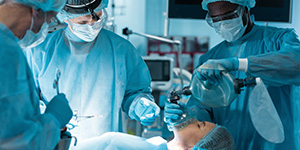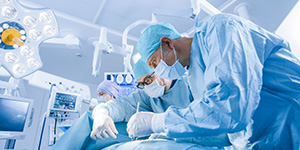In the critical hours before, during, and after surgery, it is absolutely vital to maintain normothermia. Keeping a patient’s core body temperature within a normal range helps prevent hypothermia, fight infection, and ensure a smooth recovery.
In recent years, conductive warming therapy has emerged as one of the most effective solutions for maintaining normothermia in the perioperative environment. In this blog, we’ll examine the effectiveness of conductive warming therapy in the operating theater, post-surgery, and in emergency situations.
Pre-op Warming: Setting the Stage for Patient Comfort
The best patient warming protocols are proactive, meaning they begin before a patient even goes under anesthesia. Pre-operative warming is critical to patient well-being, ensuring the patient remains comfortable, warm, and safe from hypothermia and SSI infection. Proactive warming measures benefit healthcare providers as well, ensuring smoother recoveries, less extensive hospital stays, and fewer complications.
As vital as patient warming is, it doesn’t have to be complicated! Most conductive warming therapy methods don’t take long to prepare and can be seamlessly integrated with other pre-operative protocols. In conductive warming, heat is transferred through patient devices like warming blankets or heated table pads, which providers can quickly and easily apply without throwing the pre-operative order out of balance.
Conductive Warming Therapy in the Operating Room
Despite its importance, healthcare providers still face challenges in maintaining patient temperature during surgery, including:
- Vasodilation– Anesthesia can cause blood vessels to dilate and body temperature to drop between 0.5 to 1.5 degrees Celsius.
- Surgical environment – Operating room temperatures vary, so maintaining a stable environment can prove challenging. Factors such as the number of people in the room, hot surgical lights, and equipment can impact the temperature.
- Patient exposure – Longer surgical procedures increase the risk of hypothermia as patients are exposed to the cool environment for an extended period. The longer the surgery, the more challenging it becomes to maintain the patient’s temperature.
Conductive warming therapy addresses these challenges proactively. Before hypothermia even has a chance to set in, prewarming builds a barrier of heat around the body, significantly increasing the likelihood of maintaining normothermia post-anesthesia induction.
Recovery Room: Extending the Warmth Beyond the Procedure
The risk of developing hypothermia doesn’t end with surgery. Post-surgery, the body’s ability to thermoregulate is still suppressed by the effects of anesthesia, neuromuscular blocking agents, and other drugs. To ensure a smooth recovery, patients need to be kept warm before, during, and even after a surgical procedure.
Conductive warming therapy presents an easy solution. Once a patient is in recovery, conductive patient warming devices like warming blankets and heated pads can help maintain a warm, stable temperature—not to mention keep the patient comfortable and cozy post-surgery! These methods are noninvasive and simple to operate, allowing healthcare providers to easily and comfortably maintain patient normothermia in the critical post-operative period.
Emergency Department: Swift and Efficient Warming Solutions
In an emergency, a patient’s temperature can drop—fast. Trauma patients especially are at a high risk of developing hypothermia. In the United States, it’s estimated that roughly 150,000 people die from trauma every year—700 of them due to hypothermia. Research has made clear the inextricable link between body temperature and a patient’s chance of survival, making rapid patient warming critical in emergency situations.
Healthcare providers often rely on conductive warming therapy in emergencies, due to their whole-body warming capabilities, simplicity to operate, and speed in bringing up a patient’s body temperature. Conductive warming therapy has also been shown to have a calming, even therapeutic effect on trauma patients, comparable to shock blankets, which offer protection against extreme cold and heat. In emergency settings, conductive warming devices provide instant patient care that’s reliable, effective, and potentially even lifesaving.
Introducing Norm-O-Temp: The Future of Conductive Patient Warming
Norm-O-Temp is positioned on the cutting-edge of conductive patient warming solutions. The base is compact to save space, with a small footprint for easy placement. As a whole-body system, Norm-O-Temp contains two blanket connections as well as an underbody solution allowing full access to the patient, reducing risk of hypothermia from a patient’s core to their extremities.
Norm-O-Temp also features an easy-to-use, intuitive interface for quick deployment and rapid results in emergency situations. To save time, providers can pre-condition the water, ensuring Norm-O-Temp is powered up and ready to go as soon as it’s needed. Like a fortress keeping out the cold, Norm-O-Temp defeats unintended hypothermia before it even has a chance to strike.
When trauma patients experience even mild hypothermia, bleeding can increase by 16% for each degree the temperature drops. This puts normothermia at the forefront of emergency and surgical medical care. Ready at a moment’s notice, Norm-O-Temp can greatly reduce a patient’s risk of hypothermia, raise body temperatures safely and efficiently, and ultimately save lives.
Maintaining normothermia in surgical and emergency settings is crucial for patient well-being and recovery. Conductive warming therapy methods like Norm-O-Temp have proven highly effective in addressing temperature challenges throughout the perioperative journey. From proactive pre-operative warming, which ensures patient comfort and minimizes complications, to its application in the operating room and recovery phase, conductive warming therapy provides a versatile and comfortable solution.
In emergency situations, where rapid and efficient warming is imperative, devices like Norm-O-Temp offer a cutting-edge, whole-body warming approach, saving lives by preventing hypothermia-related complications. Norm-O-Temp’s compact design, intuitive interface, and rapid deployment capabilities position it as a pivotal tool in advancing patient care, underscoring the critical role of conductive warming therapy in contemporary medical practices.
For more information about Norm-O-Temp or SourceMark’s other innovative solutions, contact a member of our team.









